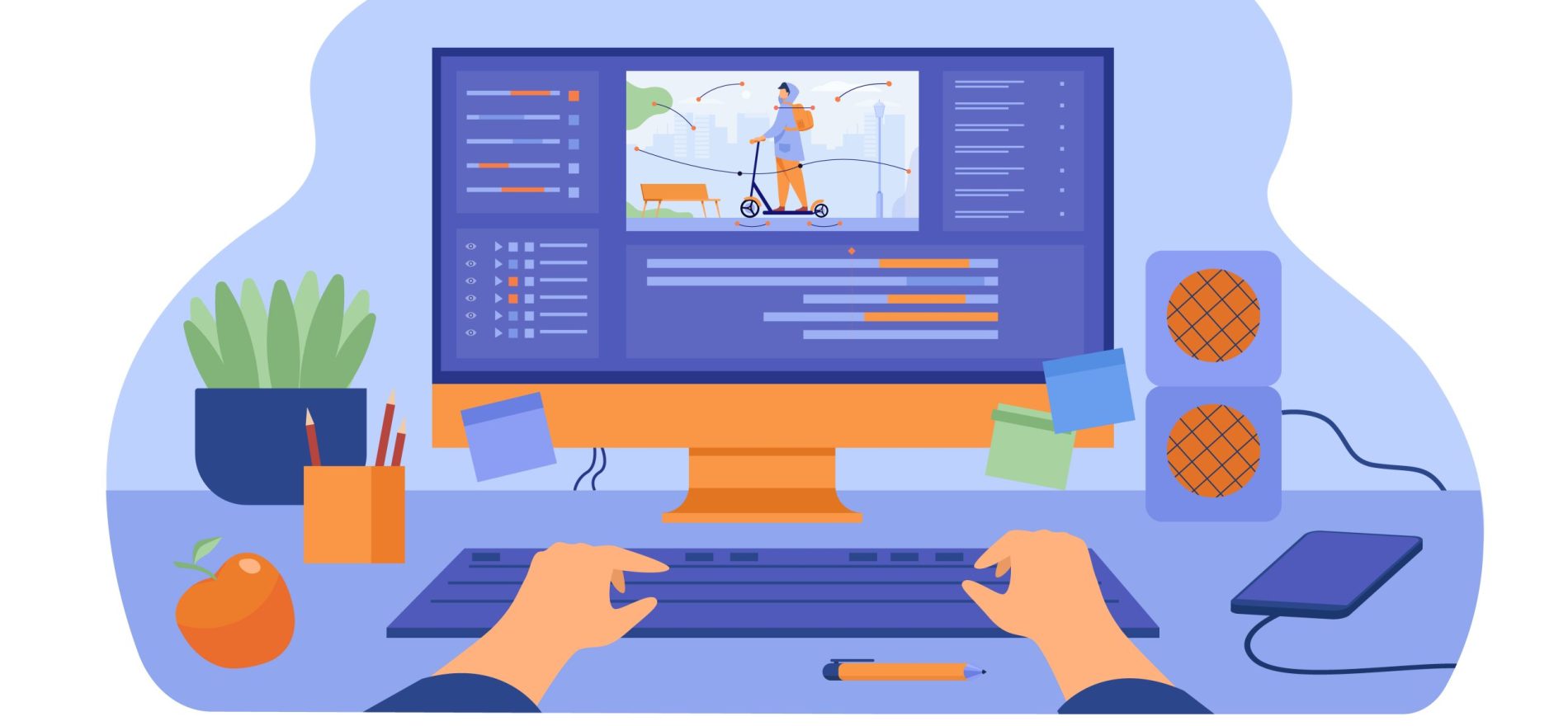Wondering how to become a freelance graphic designer? Embarking on a career in freelance graphic design holds tremendous potential. As a freelance designer, you gain the autonomy to craft your professional journey, curate a clientele of your choice, and engage in profoundly gratifying creative endeavors for your clients. Does this resonate with you? In the following article, we’ll walk you through the process of transitioning into a graphic design freelancer and illuminate the path to achieving this aspiration.
Table of Content
What is a Freelance Graphic Designer?
9 Easy Steps to Becoming a Freelance Graphic Designer
1. Be a Creative Person
2. Refine Your Graphic Design Skills
3. Enroll in a Graphic Design Course
4. Learn the Right Tools for the Job
5. Build Your Portfolio
6. Price Yourself
7. Find Yourself Some Worthy Clients
8. Build Yourself a Brand
9. Keep Working
Conclusion
What is a Freelance Graphic Designer?
The initial stride towards becoming a freelance graphic designer entails gaining a comprehensive understanding of the profession’s nuances. We define graphic design as the art of effectively conveying ideas and concepts through visual means. This designation positions graphic designers as foremost visual communicators—they take information from diverse sources and transform it into compelling visual representations. But what exactly are these visual creations they craft? In essence, they encompass a multitude. Graphic designers wield responsibility for numerous aspects that constitute our daily lives: posters and advertisements, books and magazines, applications and websites, packaging, and the very essence of how companies project their identity (commonly known as branding). Now, you’re here to glean insights into how to metamorphose into a freelance graphic designer. Graphic designers can choose to work within companies—whether in design studios, agencies or as in-house designers or they can venture into freelancing. Freelancers are the mavericks of the design realm, operating independently to create bespoke work for their own set of clients. Freelancing empowers you to carve a distinct niche in the graphic design landscape, showcasing your unique artistic imprint.
9 Easy Steps to Becoming a Freelance Graphic Designer
The prospect of being a graphic design freelancer is a thrilling journey filled with continuous evolution. Still intrigued? Here are 9 easy steps to becoming a freelance graphic designer:
1. Be a Creative Person
If you’re already engrossed in reading this, it’s safe to assume that you’ve already nailed the first step. The initial rung on the ladder towards becoming a freelance graphic designer revolves around being inherently creative. This quality is indispensable in the journey of metamorphosing into a freelance graphic designer. Given that this profession is rooted in creativity, a constant flow of creative energy is imperative day in and day out. Whether creativity is ingrained within you since birth or it’s a skill you’ve cultivated over time, possessing a creative streak sets you on the path to becoming a freelance graphic designer.
2. Refine Your Graphic Design Skills
Now that your creative reservoir is brimming, the subsequent step in your quest to become a freelance graphic designer involves refining your graphic design skills. This could unfold in two ways:
- For those who already have a background in design or have dabbled in it previously, this equates to upskilling.
- If you’re a complete novice to design, this implies embarking on a journey of learning graphic design from scratch.
For existing designers, upskilling can be a pivotal phase in their transition to becoming a freelance graphic designer. Although possessing foundational design skills is essential, it’s prudent to validate whether your knowledge aligns with the demands of the job before embarking on your freelancing journey. This stage could introduce you to certain tips and tricks that might have eluded you.
3. Enroll in a Graphic Design Course
Arguably, one of the most pivotal steps on the road to becoming a graphic design freelancer is to immerse yourself in graphic design education. And the most effective means to achieve this? Enroll in a reputable graphic design program. A high-quality graphic design course should furnish you with a comprehensive understanding of the field and equip you with the skills necessary to venture into the freelance realm. However, if the notion of spending years in training doesn’t align with your goals, fear not. A graphic design course that expedites your entry into the industry is what you seek. Allow us to introduce the ideal course for you. AAFT Online’s graphic design course offers the optimal avenue to become a freelance designer. Our innovative approach to graphic design education facilitates a swift transition into a new creative career. With a curriculum rooted in industry relevance, our course imparts aspiring designers with the essential skills, expertise, and a crucial portfolio (more on that later!) required to flourish as a freelance graphic designer. This comprehensive training spans three months full-time or nine months part-time.
4. Learn the Right Tools for the Job
Freelance graphic designers must possess a comprehensive arsenal of design tools. Software reigns supreme in a designer’s toolkit. A profound understanding of the Adobe Creative Cloud, encompassing InDesign, Illustrator, Photoshop, and the digital design application Figma, is imperative for any designer—freelance graphic designers are no exception. Therefore, the subsequent stride in your journey of becoming a graphic design freelancer involves mastering these tools.
Enrolling in a graphic design course provides a distinct advantage. You will be adeptly guided through the utilization of these four remarkable programs for diverse design tasks. While alternative avenues like self-teaching or online tutorials exist, the crux of learning software lies in practice. Devote yourself to continuous practice until you’ve internalized these tools, ultimately bolstering your journey towards freelance graphic design.
5. Build Your Portfolio
Your graphic design portfolio functions as your gateway to the industry. It showcases your capabilities, presenting a tangible representation of your work and the scope of your abilities. Moreover, your portfolio serves as your initial interaction with prospective clients. Securing a graphic design job hinges on your capacity to exhibit impressive work through your portfolio. However, your portfolio transcends mere visual allure. As a designer, you are a problem solver, and your portfolio should encapsulate not only the finished work but also the problem-solving process and the manner in which your designs address those challenges. Crafting a condensed version of your portfolio for prospective clients during pitch presentations is equally crucial. This condensed version should encompass both the finished work and the underlying design process
6. Price Yourself
The path to becoming a freelance graphic designer extends beyond design skills—it encompasses mastering the art of running your own business. A substantial facet of this undertaking involves developing the acumen and confidence to set appropriate pricing for your services. While acknowledging that graphic design expertise and quality work are precious commodities, it’s essential to strike a delicate equilibrium. Overcharging may deter potential clients, while undercharging may compromise your livelihood. Achieving this balance hinges on recognizing your value. Seeking guidance on how to determine your rates as a freelance graphic designer? A valuable strategy involves gauging your worth in comparison to fellow professionals. Evaluate your experience and proficiency vis-à-vis other freelancers in your locale and leverage this insight to establish your starting rate.
7. Find Yourself Some Worthy Clients
Embarking on the path of becoming a freelance graphic designer ushers in a formidable challenge—securing clients of merit. Beyond serving as your primary source of income, client collaborations are instrumental in curating and sustaining your portfolio. In the nascent stages of your freelancing journey, you might not have the luxury of being highly selective about clients or projects. Some work may not align with your preferences, but such experiences are integral to your growth. These initial forays pave the way for more discerning client selections in the future. In fact, establishing credibility through these initial assignments could lead to potential clients seeking you out.
Finding your inaugural client varies based on individual circumstances, but an array of strategies can bolster your visibility. Never underestimate the potency of industry buzzwords like networking and leveraging social media. These platforms are potent tools for self-promotion and work acquisition. Some freelancers have also successfully initiated contact with prospective clients directly via email, showcasing the potential of simple communication.
8. Build Yourself a Brand
With skills, portfolio, and clients in tow, it’s time to embrace a quintessential step on your voyage towards becoming a freelance graphic designer—branding yourself. While this may appear quite literal, self-branding holds paramount significance for a freelance designer. Personal branding is an avenue to infuse your individuality into your professional identity, a means of showcasing your personality, and a conduit to spotlight your capabilities to peers and potential clients alike. Your personal brand should permeate across all your public-facing platforms—your portfolio, website, social media, business cards, and beyond. You can even extend this branding to tangible items like stickers, which add a personalized touch to your self-presentation.
9. Keep Working
Congratulations, you’ve reached the zenith of your journey! You’ve diligently followed the steps to become a freelance graphic designer, and you’re now actively engaged with clients, carving your niche in the design realm. However, one final step remains—continue to work relentlessly. A substantial aspect of being a freelance designer entails perpetual growth. Your role transcends design—it encompasses all the phases outlined in this journey. Embrace perpetual creativity, refine your skills, perpetually learn, continually enrich your portfolio, review your pricing structure, and consistently pursue novel and exciting client collaborations.
Conclusion
In a nutshell, becoming a freelance graphic designer is a journey that combines creativity, skill development, and business savvy. From harnessing your creativity to building a portfolio, finding clients, and establishing your brand, each step propels you toward a dynamic career in design. Embrace this path of continuous learning, self-expression, and entrepreneurship, as you create, evolve, and thrive in the dynamic realm of graphic design.























